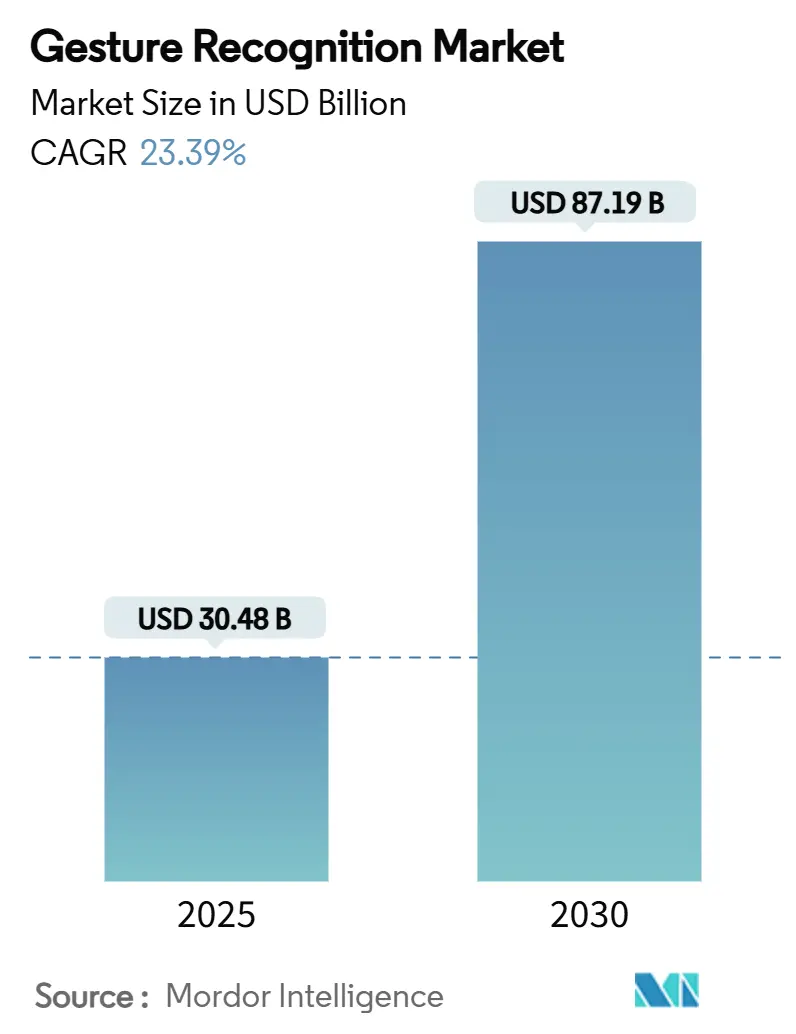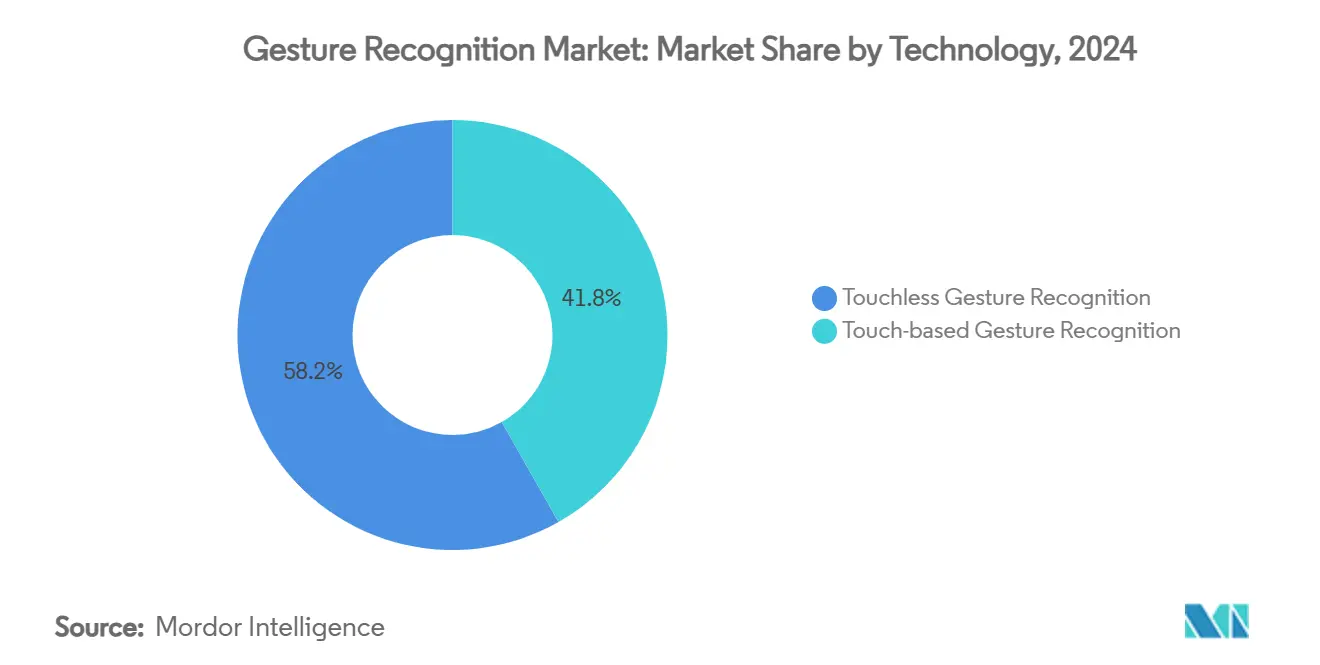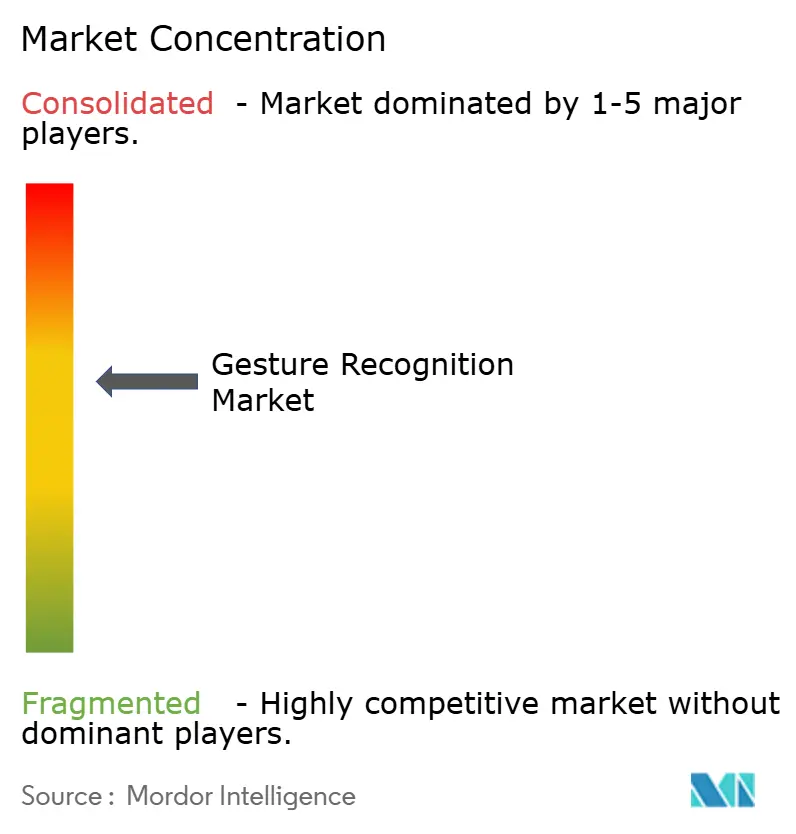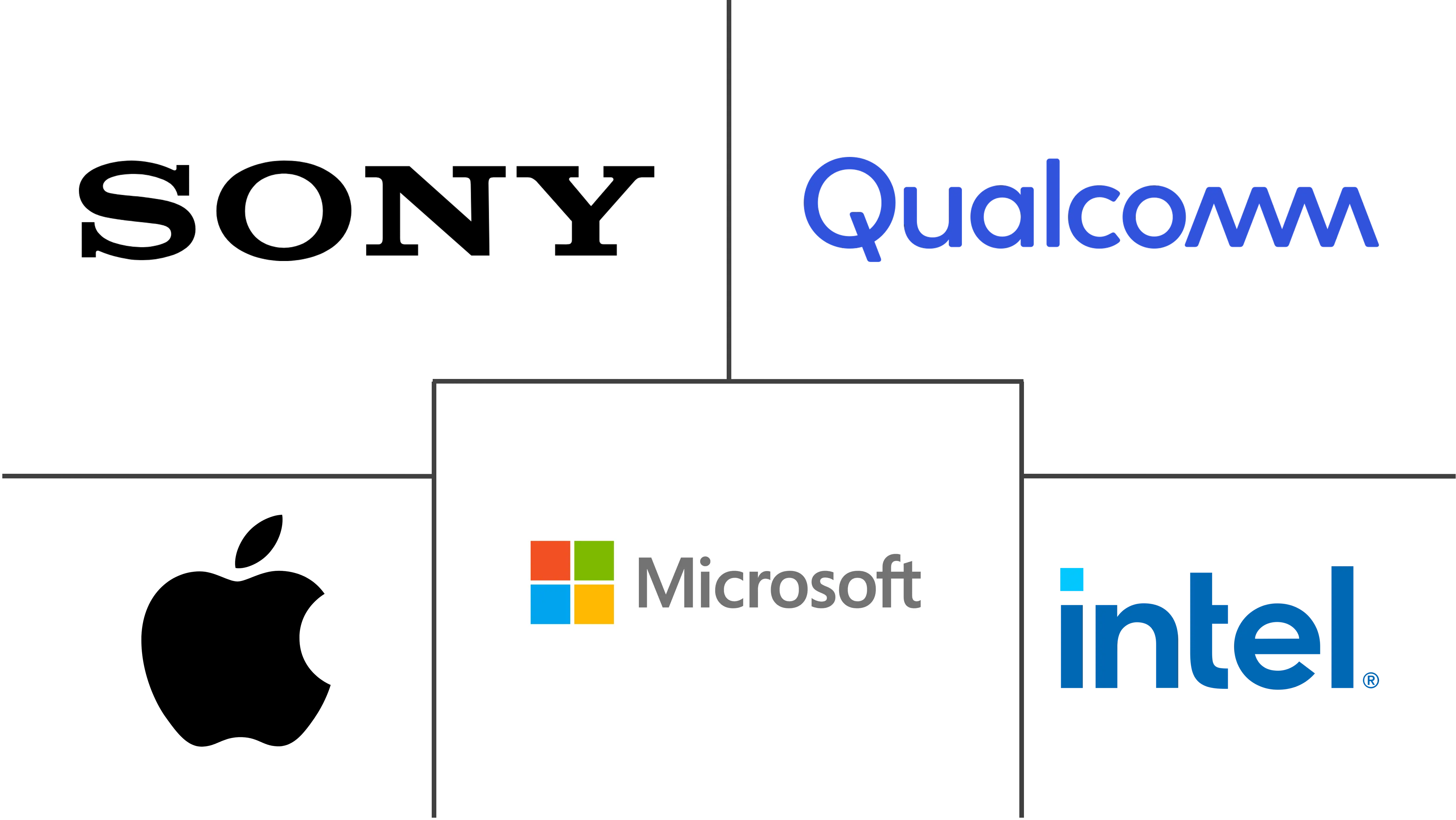Gesture Recognition Market Size and Share

Gesture Recognition Market Analysis by Mordor Intelligence
The Gesture Recognition Market size is estimated at USD 30.48 billion in 2025, and is expected to reach USD 87.19 billion by 2030, at a CAGR of 23.39% during the forecast period (2025-2030). This sustained expansion reflects the convergence of advanced millimeter-wave radar, multizone Time-of-Flight (ToF) sensors, and edge-AI algorithms that together enable responsive, low-latency human–machine interfaces across smartphones, vehicles, medical devices, and industrial equipment.[1]“Gesture Recognition,” st.com Accelerating sensor shipments in premium handsets, regulatory pressure on automotive safety systems, and infection-control imperatives in healthcare are jointly stimulating volume demand. At the same time, the gesture recognition market is witnessing a value shift from hardware-centric solutions toward software and AI stacks that personalize interactions, reduce false positives, and extend device longevity. Regional manufacturing incentives most notably the CHIPS Act in the United States and the European Chips Act are reshaping supply chains and creating new cost advantages for local component production. As these drivers converge, industry participants that integrate vertically across sensor, software, and cloud orchestration layers are positioned to capture disproportionate returns within the gesture recognition market.
Key Report Takeaways
- By technology, touchless systems led with 58.2% revenue share of the gesture recognition market in 2024; 3-D depth and ToF solutions are projected to expand at a 24.4% CAGR through 2030.
- By component, hardware accounted for 71.5% of the gesture recognition market size in 2024, while software is set to record the fastest 23.7% CAGR to 2030.
- By end-user industry, consumer electronics commanded 42.6% of gesture recognition market share in 2024, whereas healthcare is the fastest-growing segment at 24.9% CAGR to 2030.
- By gesture type, dynamic gestures commanded 57.0% of gesture recognition market share in 2024, whereas it is the fastest-growing segment at 23.4% CAGR to 2030.
- By authentication, non-biometric (motion/pose) accounted for 81.0% of the gesture recognition market size in 2024, while biometric is set to record the fastest 24.2% CAGR to 2030.
- By geography, Asia Pacific held 38.3% of gesture recognition market share in 2024 and is forecast to advance at a 24.1% CAGR through 2030.
Global Gesture Recognition Market Trends and Insights
Drivers Impact Analysis
| Driver | (~) % Impact on CAGR Forecast | Geographic Relevance | Impact Timeline |
|---|---|---|---|
| Proliferation of mm-wave and ToF sensors in flagship smartphones across Asia | +4.2% | Asia Pacific core, spill-over to global markets | Medium term (2-4 years) |
| Automaker adoption of in-cabin gesture HUDs to meet Euro NCAP distraction mandates | +3.8% | Europe primary, North America secondary | Short term (≤ 2 years) |
| Hospital demand for touch-free HMI to cut HAI risks in surgical suites | +3.5% | North America & EU, expanding to APAC | Medium term (2-4 years) |
| Integration into XR wearables to unlock 6-DoF control for industrial training | +2.9% | Global, with early gains in Japan, Germany, US | Long term (≥ 4 years) |
| Smart-TV vendors bundling air-gesture remotes to differentiate in price-eroding market | +2.1% | Global consumer markets | Short term (≤ 2 years) |
| Government smart-city grants driving public-kiosk gesture UI roll-outs | +1.8% | GCC primary, expanding to emerging markets | Medium term (2-4 years) |
| Source: Mordor Intelligence | |||
Proliferation of mm-wave and ToF sensors in flagship smartphones across Asia
Asia-based handset OEMs now embed multizone ToF modules such as STMicroelectronics’ VL53L7CX to deliver millimeter-level depth accuracy without ambient-light restrictions, enabling reliable mid-air command input even under harsh illumination. The deployment extends to smart-TV handsets through Ceva’s MotionEngine Hex firmware, which integrates inertial and radar data to deliver spatial control of user interfaces.[2]“Ceva Launches MotionEngine Hex,” eejournal.com As the cost of ToF chipsets falls below USD 1 per unit in volume lots, gesture control is transitioning from a premium differentiator to a default feature in the gesture recognition market.
Automaker adoption of in-cabin gesture HUDs to meet Euro NCAP mandates
The July 2024 Advanced Driver Distraction Warning regulation obliges OEMs to mitigate cognitive load, propelling rapid integration of camera-based gesture hubs in European models.[3]“EU Regulation on Advanced Driver Distraction Warning Systems,” interregs.com BMW’s Level 2/3 certification on the 7 Series demonstrates commercial readiness, while Audi’s 3-D cockpit interface showcases multi-modal infotainment selection using above-console hand sweeps. Suppliers that can guarantee sub-150 ms response times and <3% false-trigger rates stand to win program awards, reinforcing the growth trajectory of the gesture recognition market.
Hospital demand for touch-free HMI to cut HAI risks in surgical suites
Clinical studies show 93% accuracy for mid-air MRI image manipulation, with contextual filtering reducing false positives to 2.3% in sterile environments. Neonode’s holographic displays eliminate high-touch surfaces in intensive-care units, addressing infection-control regulations and justifying higher ASPs.[4]“Holographic Displays,” neonode.com These hospital deployments create a premium sub-segment that values accuracy and regulatory compliance over bill-of-materials cost, expanding profit pools within the gesture recognition market.
Integration into XR wearables to unlock 6-DoF control for industrial training
Hitachi’s metaverse training platform allows journeyman technicians to shadow master operators in virtual settings, capturing tacit knowledge while using gesture sensing for machine interaction. Ultraleap and Prophesee combine event-based vision with low-power optics to sustain all-day AR sessions, reducing battery drain that previously limited adoption. These innovations position gesture recognition as the natural interface for immersive enterprise productivity, adding a long-tail growth vector to the gesture recognition market.
Restraints Impact Analysis
| Restraint | (~) % Impact on CAGR Forecast | Geographic Relevance | Impact Timeline |
|---|---|---|---|
| High false-positive rates in sunlight for vision-based systems in tropical regions | -2.8% | APAC tropical regions, Middle East, parts of Africa | Short term (≤ 2 years) |
| Absence of open interoperability standards inflating OEM integration cost | -2.1% | Global, particularly affecting smaller OEMs | Medium term (2-4 years) |
| 'Always-on' gesture wake-word draining battery in sub-10 nm mobile SoCs | -1.9% | Global mobile device markets | Short term (≤ 2 years) |
| Data-privacy compliance hurdles for in-cabin video analytics under GDPR | -1.5% | Europe primary, with spillover to privacy-conscious markets | Long term (≥ 4 years) |
| Source: Mordor Intelligence | |||
High false-positive rates in sunlight for vision-based systems in tropical regions
Camera-centric algorithms struggle to resolve hand contours against high-lux backgrounds, driving error spikes in outdoor kiosks and ride-hailing vehicles. Research indicates radar-based alternatives maintain >90% precision independent of illumination, prompting system designers to adopt multi-sensor fusion in the gesture recognition market.
Absence of open interoperability standards inflating OEM integration cost
Fragmented SDKs force smaller manufacturers to invest in custom middleware, lengthening design cycles by up to six months. Synaptics’ open-source Astra platform seeks to harmonize APIs around its AI-native chipsets, but an industry-wide standard remains elusive, curbing the addressable volume available to entrants.
Segment Analysis
By Technology: Touchless systems drive premium applications
Touchless solutions generated 58.2% of 2024 revenue, reflecting end-market emphasis on hygiene, driver safety, and immersive entertainment. The touchless sub-segment will compound at 24.4% through 2030, outpacing the broader gesture recognition market as ToF, mm-wave radar, and ultrasonic arrays reduce bill-of-materials cost. In contrast, capacitive touch-based controls retain relevance in cost-sensitive consumer devices, yet their CAGR trails at single-digits. Kyocera’s depth sensor demonstrates 100 µm resolution within 10 cm, enabling robotic pick-and-place and orthopedic alignment tools that demand surgical-grade accuracy. The steady migration toward ambient interaction implies touchless modalities will ultimately hold a greater gesture recognition market share than their contact-dependent predecessors.
Touchless expansion is altering supplier power dynamics. Sensor vendors that historically commoditized silicon are now bundling AI firmware, data models, and developer portals, capturing recurring license fees on top of hardware margins. This re-bundling aligns with OEM priorities for field-upgradable over-the-air performance improvements and supports the scalable economics required for high-volume touchless adoption within the gesture recognition market.

By Component: Hardware dominance faces software disruption
Hardware contributed 71.5% of gesture recognition market size in 2024, driven by the intrinsic cost of lenses, radar front-ends, and MCUs. However, software platforms that deliver contextual awareness, user adaptation, and federated learning are forecast at a 23.7% CAGR—more than 350 bps above hardware growth. Infineon’s DEEPCRAFT Ready Models supply pre-trained neural networks for common gestures, cutting integration time by 40% and repositioning the firm higher on the value curve. Meanwhile, Imagimob’s visual graph-based ML tooling compresses model-development cycles to hours, democratizing AI optimization for mid-tier OEMs.
The revenue mix shift creates opportunities for service bundling: predictive maintenance, cloud-based analytics, and in-app monetization through gesture-initiated digital purchases. Suppliers able to orchestrate silicon, firmware, and lifecycle services are poised to command loyalty in the gesture recognition market as total cost of ownership eclipses component price considerations.
By End-user Industry: Healthcare disrupts consumer electronics leadership
Consumer electronics retained a 42.6% share in 2024, benefitting from smartphone replacement cycles and smart-TV attach rates that embed mid-air navigation as table-stakes functionality. Even so, surgical theaters, radiology labs, and cleanroom diagnostics will post a 24.9% CAGR, reflecting infection-prevention protocols and reimbursement incentives that justify higher system ASPs. Automotive adoption is accelerating, fueled by driver distraction mandates and Level 2+ autonomy roadmaps requiring intuitive fallback controls. Industrial cobots and hazardous-material robotics add incremental demand where glove-friendly interfaces are mandatory.
In healthcare, ROI materializes through shorter procedure times, lower surgical-site infection rates, and reduced consumable spend on sterile drapes. These quantifiable benefits underpin premium pricing and elevate medical OEM influence over component roadmaps, further diversifying revenue streams across the gesture recognition industry.
By Gesture Type: Dynamic gestures enable complex interactions
Dynamic gestures held a 57% revenue share in 2024 and will continue compounding at 23.4% as temporal recognition models mature. Researchers report 95.1% precision in ultra-long-distance detection up to 28 m by combining radar and vision data. Static pose recognition remains relevant for binary start-stop machine controls, yet user preference trends toward motion-rich commands that mirror natural language.
Attention-enhanced LSTM networks push real-time inference below 10 ms, supporting immersive gaming and remote-surgery use cases that demand latency-free feedback. Over time, dynamic modalities are expected to command an even larger slice of the gesture recognition market share as model compression aligns with edge-compute budgets.

By Authentication: Biometric security gains momentum
Non-biometric motion patterns represented 81% of 2024 implementations, thanks to lone-user consumer electronics scenarios that value convenience. Yet biometric gesture authentication combining finger-vein, iris, or impedance signatures with motion vectors is advancing at 24.2% CAGR.
Infineon’s SECORA Pay Bio cards fuse fingerprint and gesture confirmation to authorize contactless payments, closing the security gap without degrading user experience. Wearable patents that map muscular impedance hint at continuous authentication, ensuring only the registered user can execute privileged gestures during prolonged sessions. Such developments are elevating the security profile of the gesture recognition market, widening its addressable scope to regulated industries.
Geography Analysis
Asia Pacific’s dominance rests on vertically integrated supply chains, supportive government funding, and an immense installed base of early-adopter consumers. Regional handset brands release new flagship lines every 10–12 months, each iteration embedding higher-resolution ToF arrays, thereby expanding the gesture recognition market size for sensor vendors. Japanese conglomerates employ XR-based skill-transfer platforms in automotive welding and semiconductor lithography, reinforcing demand for high-precision gesture models. South Korea’s wafer capacity secures component continuity, while India’s smart-TV expansion introduces touchless remotes into middle-income households, broadening the revenue pyramid.
North America leverages healthcare spending power for surgical suites and diagnostic centers, generating premium revenue per unit. Hospitals adopting mid-air displays report significant reductions in cross-contamination incidents, translating into lower readmission penalties and bolstering ROI for gesture interfaces. Automotive OEMs integrate gesture-based driver monitoring to comply with post-2024 federal guidelines on distracted driving, pushing incremental sensor attach rates.
Europe acts as a regulatory pacesetter. Euro NCAP directives mandate distraction-mitigation technologies, accelerating deployment across both luxury and mass-market vehicle classes. German suppliers co-develop gesture modules with domestic automakers, cementing regional value capture despite globalized hardware sourcing. Meanwhile, GCC nations pursue AI sovereignty initiatives that fund public-service kiosks with touchless UIs, giving the Middle East an outsized growth profile relative to its current base.

Competitive Landscape
The gesture recognition market remains moderately fragmented. Semiconductor majors Intel, Qualcomm, Infineon bundle CPU, GPU, and RF blocks that accelerate sensor fusion, leveraging scale advantages to defend gross margins. Specialist firms such as Ultraleap differentiate through high-fidelity hand tracking and mid-air haptics, targeting premium automotive and XR segments. Synaptics positions at the confluence of silicon and software, offering Astra AI-Native development stacks that shorten OEM integration timelines.
Strategically, consolidation centers on capability acquisition. Infineon’s new SURF division combines radar and sensor assets to expand automotive design-in depth, signaling a portfolio-management approach that aligns adjacent technologies under a common go-to-market. PreAct Technologies’ 2024 purchase of Gestoos AI added proprietary gesture datasets, enhancing model generalization across in-cabin and industrial robotics use cases. Competitive advantage now derives from vertically integrated reference designs, cloud-based model updates, and compliance toolkits that de-risk OEM audits.
White-space opportunities persist in hazardous-material handling, elder-care robotics, and accessibility tech for differently abled users. Entrants that can supply domain-specific training data and verification protocols stand to capture niche share pockets even as industry leaders lock down mainstream mobile and automotive sockets. Within this landscape, the gesture recognition market rewards firms that marry silicon roadmaps with AI model pipelines and certified reference flows.
Gesture Recognition Industry Leaders
-
Intel Corporation
-
Qualcomm Technologies Inc.
-
Apple Inc.
-
Microsoft Corp.
-
Sony Group Corp.
- *Disclaimer: Major Players sorted in no particular order

Recent Industry Developments
- June 2025: Elliptic Labs optimized its AI platform for Ceva’s NeuPro-Nano NPU, cutting inference latency and boosting battery life in wearables.
- March 2025: Synaptics unveiled ultra-low-power MCUs at Embedded World, expanding its portfolio of context-aware edge devices for gesture interfaces.
- January 2025: Infineon formed the SURF business unit to consolidate sensor and RF assets for automotive and HMI growth vectors.
- November 2024: Infineon introduced the DEEPCRAFT edge-AI brand, delivering pre-trained models that accelerate gesture deployment for embedded designers.
Global Gesture Recognition Market Report Scope
Gesture recognition is the conversion of human movements or signals to commands using a mathematical algorithm. It enables people to interrelate with machines in the absence of physical devices as an input mechanism to perform desired actions in a system. The technology interprets human gestures and movements, such as the movement of hands, fingers, arms, head, or the entire body. It allows users to operate and control devices merely with their gestures.
The gesture recognition market is segmented by technology (touch-based gesture recognition, touchless gesture recognition), end-user industry (automotive, healthcare, consumer electronics, gaming, aerospace and defense, and other end-user industries), and geography (North America, Latin America, Europe, Asia-Pacific, and Middle East and Africa).
The market sizes and forecasts are provided in terms of value USD for all the above segments.
| Touch-based Gesture Recognition | 2-D Multi-touch Panels |
| Capacitive and Resistive Sensors | |
| Touchless Gesture Recognition | 2-D Camera-based |
| 3-D Depth and ToF | |
| Ultrasonic and mm-wave Radar |
| Hardware (Sensors, Controllers, SoCs) |
| Software (ML Algorithms, SDKs, Middleware) |
| Online Dynamic Gestures |
| Offline Static Gestures |
| Biometric (Face, Iris, Palm-vein) |
| Non-biometric (Motion, Pose) |
| Consumer Electronics | Smartphones and Tablets |
| Smart-TV and Set-top Boxes | |
| AR/VR and Wearables | |
| Automotive | Driver Monitoring and Infotainment |
| Aerospace and Defense | |
| Healthcare | Surgical and Diagnostic Rooms |
| Gaming and Entertainment | |
| Industrial and Robotics | |
| Other Industries |
| North America | United States |
| Canada | |
| Mexico | |
| South America | Brazil |
| Argentina | |
| Rest of South America | |
| Europe | United Kingdom |
| Germany | |
| France | |
| Italy | |
| Rest of Europe | |
| Asia Pacific | China |
| Japan | |
| India | |
| South Korea | |
| New Zealand and Australia | |
| Rest of Asia Pacific | |
| Middle East and Africa | GCC (Saudi Arabia, UAE, Qatar) |
| Turkey | |
| South Africa |
| By Technology | Touch-based Gesture Recognition | 2-D Multi-touch Panels |
| Capacitive and Resistive Sensors | ||
| Touchless Gesture Recognition | 2-D Camera-based | |
| 3-D Depth and ToF | ||
| Ultrasonic and mm-wave Radar | ||
| By Component | Hardware (Sensors, Controllers, SoCs) | |
| Software (ML Algorithms, SDKs, Middleware) | ||
| By Gesture Type | Online Dynamic Gestures | |
| Offline Static Gestures | ||
| By Authentication | Biometric (Face, Iris, Palm-vein) | |
| Non-biometric (Motion, Pose) | ||
| By End-user Industry | Consumer Electronics | Smartphones and Tablets |
| Smart-TV and Set-top Boxes | ||
| AR/VR and Wearables | ||
| Automotive | Driver Monitoring and Infotainment | |
| Aerospace and Defense | ||
| Healthcare | Surgical and Diagnostic Rooms | |
| Gaming and Entertainment | ||
| Industrial and Robotics | ||
| Other Industries | ||
| By Geography | North America | United States |
| Canada | ||
| Mexico | ||
| South America | Brazil | |
| Argentina | ||
| Rest of South America | ||
| Europe | United Kingdom | |
| Germany | ||
| France | ||
| Italy | ||
| Rest of Europe | ||
| Asia Pacific | China | |
| Japan | ||
| India | ||
| South Korea | ||
| New Zealand and Australia | ||
| Rest of Asia Pacific | ||
| Middle East and Africa | GCC (Saudi Arabia, UAE, Qatar) | |
| Turkey | ||
| South Africa | ||
Key Questions Answered in the Report
What is the current size of the gesture recognition market?
The gesture recognition market reached USD 30.48 billion in 2025 and is projected to grow to USD 87.19 billion by 2030.
Which region leads the gesture recognition market?
Asia Pacific holds the largest 38.3% share and is forecast to post the fastest 24.1% CAGR through 2030.
Why are touchless technologies expanding rapidly?
Hospitals, automakers, and consumer-electronics brands value hygienic and distraction-free interfaces, driving a 24.4% CAGR for touchless solutions.
How is software changing competitive dynamics?
AI-centric software platforms are growing faster than hardware, enabling continuous model updates and personalized experiences that raise switching costs.
What industries offer the highest growth opportunity?
Healthcare tops the expansion chart with a 24.9% CAGR to 2030 as surgical and diagnostic centers adopt sterile, mid-air controls.
How fragmented is the supplier landscape?
The top 10 players hold under 30% combined revenue, indicating ample space for new entrants with differentiated sensor or AI capabilities.
Page last updated on:



